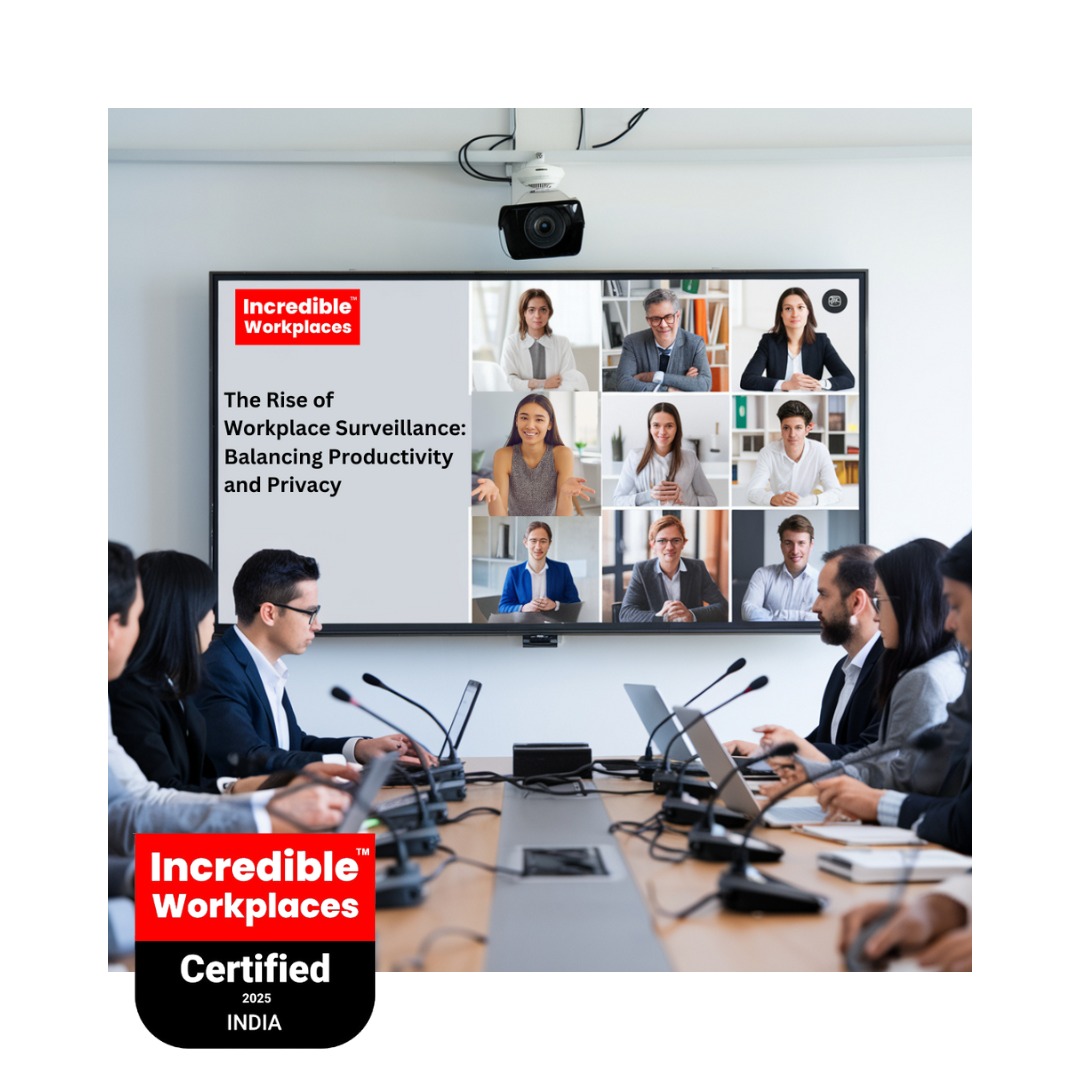Incredible Workplaces (™) | Get Certified
The Rise of Workplace Surveillance: Balancing Productivity and Privacy
- Home
- The Rise of Workplace Surveillance: Balancing Productivity and Privacy



The Rise of Workplace Surveillance: Balancing Productivity and Privacy
As technology becomes increasingly embedded in everyday business operations, workplace surveillance has emerged as both a tool for enhancing productivity and a potential threat to employee privacy. Today’s organizations face the dual challenge of leveraging data and monitoring tools to optimize performance while ensuring that employees feel trusted, secure, and respected. In this post, we explore the data-driven impact of workplace surveillance, examine the concerns it raises regarding privacy, and discuss strategies that middle managers and leadership can employ to strike the right balance. Companies that successfully navigate this balance not only drive better performance but also pave the way for formal recognitions such as Workplace culture certification, Employee well-being certification, and Workplace excellence awards. This, in turn, positions them as contenders for Best Places to Work certification and as true examples of Incredible Workplaces in India.
The Growing Trend of Workplace Surveillance
A Data-Driven Shift in Monitoring
The adoption of workplace surveillance technologies has accelerated over recent years. Organizations are using an array of digital tools—from keystroke monitoring and email tracking to advanced AI-driven analytics—to gather real-time data on employee productivity and workflow. According to recent industry reports, more than 60% of large companies in North America and Europe have implemented some form of digital monitoring to assess employee performance. These tools have been credited with identifying workflow inefficiencies, reducing operational costs, and ultimately increasing productivity by up to 20% in some cases.
The rationale behind this surge in surveillance is clear: In a competitive global marketplace, every minute counts. Data collected through these technologies offers leaders granular insights into how work gets done, which can inform decisions and streamline processes. However, as companies lean into these innovations, it becomes crucial to address the flip side of the coin—privacy concerns and the potential erosion of trust among staff.
Balancing the Scales: Productivity vs. Privacy
The Productivity Promise
Workplace surveillance tools provide tangible benefits. By monitoring employee activity, companies can identify bottlenecks and reallocate resources to enhance efficiency. For example, an internal study conducted at a multinational firm showed that teams using productivity analytics experienced a 15% improvement in output compared to those that did not. Surveillance can also act as a preventive measure, reducing instances of time theft and ensuring that deadlines are met consistently.
Moreover, this data-centric approach supports an Organizational culture assessment that helps leaders determine whether their current practices align with overall strategic objectives. When used responsibly, surveillance data can serve as a cornerstone for process improvements and is often highlighted in companies pursuing Workplace culture certification.
Privacy Concerns and Employee Trust
On the other side of the spectrum, concerns over employee privacy are mounting. A survey by a leading HR firm found that 30% of employees feel uneasy about continuous digital monitoring, fearing it may lead to intrusive oversight that stifles creativity and lowers morale. The fear is that surveillance might be used as a tool for excessive control rather than a means to support performance improvement.
Privacy concerns can directly impact employee well-being. Studies indicate that when workers feel they are constantly watched, stress levels can increase and overall job satisfaction can drop—factors that are critical when pursuing Employee well-being certification. Furthermore, diminished trust can harm collaboration, potentially affecting an organization’s ability to earn Workplace excellence awards and achieve Best Places to Work certification.
Strategies for Ethical and Effective Surveillance
Finding the right balance between leveraging surveillance for productivity and preserving employee privacy is not straightforward. However, several strategies can help organizations achieve this delicate equilibrium:
1. Transparent Communication
Clear and open communication is paramount. Employers must explain the rationale behind surveillance measures, emphasizing that the goal is to improve processes rather than to micromanage every move. Involving employees in the decision-making process and setting clear guidelines can help mitigate concerns. Transparency not only builds trust but also reinforces the organization’s commitment to ethical practices—an important consideration when undergoing an Organizational culture assessment.
2. Ethical Guidelines and Data Governance
Implementing strict ethical guidelines and robust data governance policies is essential. Organizations should establish what data will be collected, how it will be used, and who will have access to it. Regular audits and reviews of surveillance practices can ensure that the tools are used appropriately and that any potential biases are identified and addressed. Such measures are critical for companies aiming to achieve Workplace culture certification and Employee well-being certification, as they demonstrate a commitment to balancing productivity with ethical considerations.
3. Limited and Purpose-Driven Monitoring
Rather than deploying blanket surveillance across all activities, companies can opt for targeted monitoring that focuses on specific metrics tied directly to productivity. For instance, monitoring could be limited to workflow bottlenecks or project progress rather than tracking every keystroke. This approach minimizes invasiveness and helps preserve employee autonomy while still providing valuable insights for improving performance—a key factor for earning Workplace excellence awards.
4. Employee Involvement and Feedback
Regularly soliciting employee feedback on surveillance practices can help ensure that policies remain fair and effective. Pulse surveys and focus groups can gauge how employees feel about monitoring, providing actionable insights for adjustments. When employees see that their concerns are taken seriously, they’re more likely to trust that surveillance is being used in a supportive manner. This feedback loop is a critical component of a strong Organizational culture assessment.
5. Balancing Remote and In-Person Work
In today’s hybrid work environment, the dynamics of surveillance can differ between remote and in-office employees. Companies should tailor their monitoring practices to the context—using tools that respect the flexibility of remote work while ensuring that in-office practices remain efficient. This nuanced approach helps ensure that all employees feel valued, regardless of where they work, and supports efforts to achieve Best Places to Work certification.
Case Studies: Successes and Lessons Learned
International Insights
In countries like the United States and parts of Europe, forward-thinking companies have successfully implemented surveillance tools with a focus on transparency and ethical use. One multinational technology firm, for example, adopted a policy of limited, purpose-driven monitoring. They communicated clearly with their teams, setting strict data usage boundaries, and as a result, saw a 15% boost in productivity while maintaining high employee satisfaction levels. Such success stories are often highlighted during Workplace excellence awards ceremonies and contribute to the organization’s bid for Workplace culture certification.
Examples from India
In India, progressive companies are leveraging digital tools not only to optimize workflow but also to enhance employee well-being. Several organizations have integrated surveillance practices into a broader framework of digital transformation while ensuring that employee privacy is respected. By conducting regular Organizational culture assessments and soliciting feedback, these companies have managed to balance efficiency with respect for personal space—an approach that has helped them earn recognition as part of the Incredible Workplaces in India movement.
The Future of Workplace Surveillance
Looking ahead, the conversation around workplace surveillance is set to evolve. With advancements in AI and machine learning, surveillance tools will become even more sophisticated, offering deeper insights while posing new challenges for privacy. The key for future success lies in adopting a human-centric approach that prioritizes ethical practices and continuous improvement.
Organizations that can successfully balance these demands will not only drive higher productivity but also create an environment where employees feel trusted and supported. This commitment to ethical, data-driven practices is essential for achieving formal recognitions such as Workplace culture certification and Employee well-being certification—markers of a forward-thinking, inclusive, and high-performing organization.
Conclusion
The rise of workplace surveillance represents both an opportunity and a challenge. On one hand, these technologies offer unprecedented insights into productivity and workflow efficiency, which can be transformative when used responsibly. On the other hand, they raise critical concerns about privacy and trust that, if not addressed, can undermine employee morale and well-being.
For middle managers and organizational leaders, the goal is to harness the power of surveillance tools without compromising on ethical standards. By committing to transparent communication, implementing strict data governance, adopting targeted monitoring strategies, and continuously involving employees in the feedback process, companies can strike a balance that enhances productivity while safeguarding privacy.
In today’s competitive landscape, where recognition through Workplace culture certification, Employee well-being certification, and Workplace excellence awards can set you apart as a leader, it is essential to integrate surveillance practices that are both effective and respectful. Achieving these goals not only improves operational efficiency but also contributes to the overall employer brand—helping your organization earn prestigious recognitions such as Best Places to Work certification and positioning it as one of the Incredible Workplaces in India.
Embrace a balanced approach to workplace surveillance and lead your organization into a future where technology empowers employees, drives innovation, and creates a culture of trust and excellence.
By
Govind Singh Negi
Founder &CEO of Incredible Workplaces(™)
